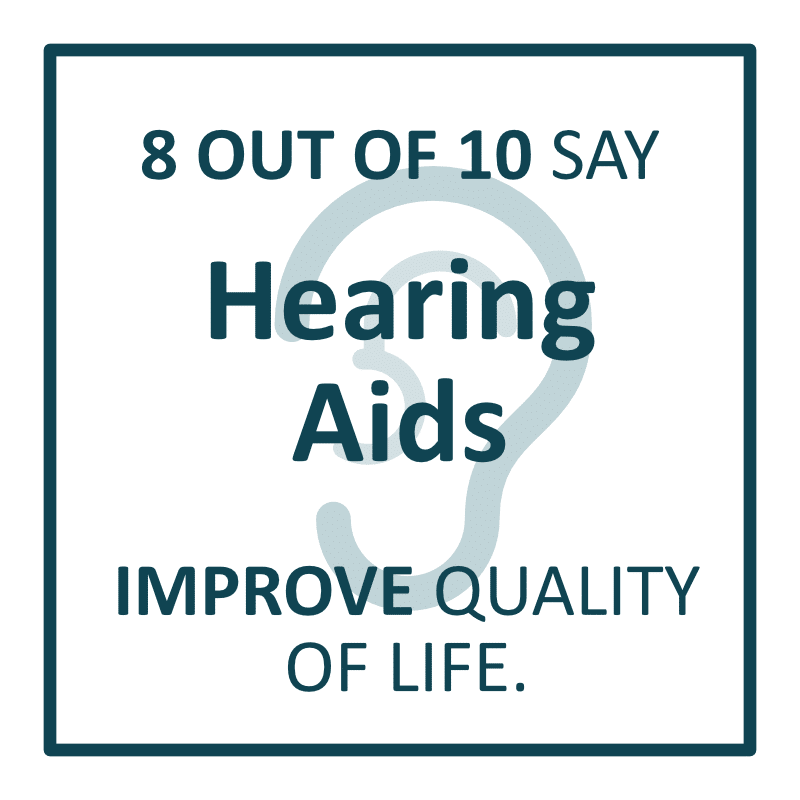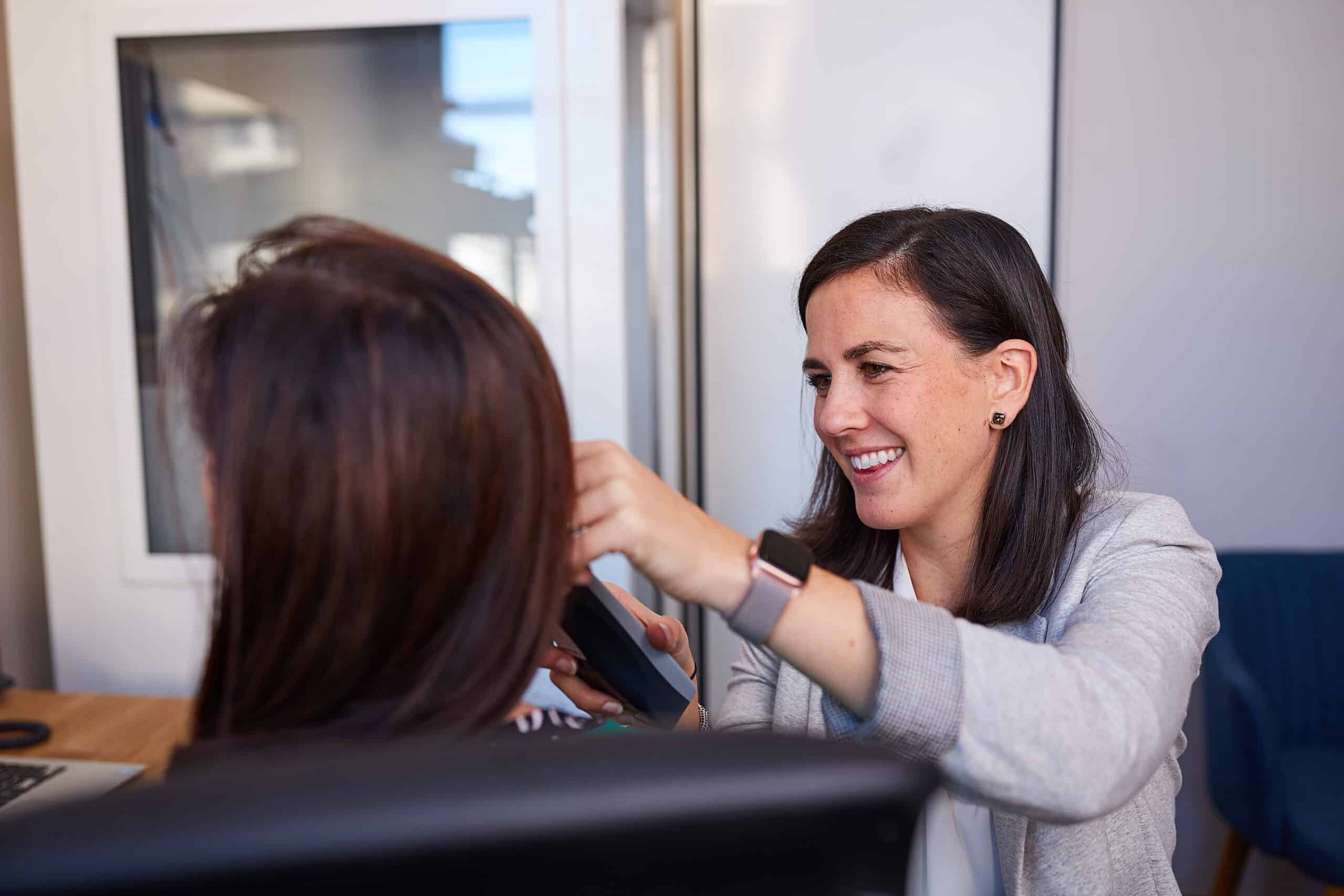Hearing Aids
Treating hearing losSHearlix audiologists understand that addressing hearing loss extends beyond simply fitting a hearing aid. We are committed to helping you explore and select the most suitable hearing device options, while ensuring an expert and precise fitting process.
With a staggering selection of over 2000 different hearing aids available in Australia, it can be overwhelming to determine the best solution. At Hearlix, our unique approach will guide you towards the hearing aids that best suit your specific needs. Your search for ‘hearing aids near me’ ends here!
What is a hearing aid?
A hearing aid is a small electronic device designed to be worn in or over a person’s ear in order to improve their hearing ability when hearing loss is diagnosed. It consists of several components that work together to amplify and clarify sound, making it easier for people with hearing loss to hear and understand speech and other sounds in their environment.
Hearing aids also include additional modern enhancements, including wireless connectivity to mobile phones and other smart devices, and other accessories which can make speech even easier to hear over distance and in background noise.
What isn’t a hearing aid?
While modern hearing aids offer remarkable benefits, it’s crucial to recognise that they are not a cure for hearing loss. They can only utilise the residual hearing ability that remains.
Additionally, adjusting to hearing aids can take time, and individuals often find it easier to adapt if they acquire them earlier in their journey with hearing loss.
Hearing loss can make it difficult to communicate with others, which can impact your quality of life in a number of ways. For example, you may have trouble following conversations, participating in social activities, or even feeling safe.

These factors underscore the importance of early identification of hearing loss. By identifying hearing loss early, individuals can optimise their remaining hearing ability and facilitate a smoother transition to using hearing aids.
Hearing loss affects every aspect of communication

Hearing loss can make it difficult to communicate with others, which can impact your quality of life in a number of ways. For example, you may have trouble following conversations, participating in social activities, or even feeling safe.
Hearing Aids Improve Quality of Life
-
Hearing aids can help to improve your hearing and communication skills, which can lead to a number of benefits, including:
- Improved Communication: Hearing aids can significantly enhance your ability to communicate with others. By amplifying sounds and improving speech clarity, they make it easier to understand conversations, participate in social interactions, and maintain meaningful connections with loved ones.
- Enhanced Cognitive Function: Hearing loss has been linked to cognitive decline and an increased risk of conditions like dementia. Wearing hearing aids can help stimulate your auditory system, keeping your brain actively engaged and potentially reducing the risk of cognitive decline.
- Better Emotional Well-being: Untreated hearing loss can lead to feelings of isolation, frustration, and even depression. Hearing aids can alleviate these negative emotions by restoring your ability to fully participate in conversations and enjoy social activities.
- Increased Safety and Awareness: Hearing aids help you stay alert to your surroundings, allowing you to detect important sounds such as alarms, approaching vehicles, and other potential hazards. This promotes personal safety and independence.
- Professional Success: Hearing loss can hinder your performance in professional settings, affecting your productivity and communication with colleagues. By improving your hearing, hearing aids can enhance your job performance and increase opportunities for career advancement.
- Enjoyment of Everyday Activities: Whether it’s listening to music, watching movies, or engaging in hobbies, hearing aids can enhance your enjoyment of everyday activities by restoring the richness and depth of sound.
- Preserving Relationships: Untreated hearing loss can strain relationships due to misunderstandings and communication difficulties. By using hearing aids, you can improve your ability to connect with others, strengthening and preserving your relationships.
Types of hearing aids
Behind-the-Ear (BTE) Hearing Aids
These hearing aids are worn behind the ear and consist of a case that houses the electronics. They are connected to the ear canal via a plastic tube or earmold.
Pros: BTEs are versatile, suitable for various degrees of hearing loss, and can accommodate different features and power levels. They are also considered to be the most robust and water and dust resistant.
Cons: As the case sits behind the ear, some people find they can interfere with glasses. As all electronic components reside within the behind the ear case, they may not be the smallest package compatible with a person’s hearing loss.
In-the-Ear (ITE) Hearing Aids
ITE hearing aids are custom-made to fit in the outer portion of the ear. They are available in different sizes, including full-shell (fills most of the bowl-shaped area), half-shell (fills half of the bowl-shaped area), in-the-canal (ITC), and completely-in-the-canal (CIC).
Pros: ITE hearing aids can be made to be more discreet than BTEs, especially small completely in the canal (CIC) models, which may be almost invisible. ITE models won’t interfere with glasses, and larger sizes can be easier to handle for those with dexterity issues.
Cons: ITEs are limited to the available space within a person’s ears, so some narrow ear canals may not permit the fitting of very small models. ITEs may also lack features available in BTE models, due to less space to fit additional electronic components required for features like Bluetooth connectivity, advanced microphone modes or higher power options for more significant degrees of hearing loss.
Location within the ear and/or ear canal means ITE styles are susceptible to ear moisture damage and thus may need more frequent servicing than their BTE counterparts.
Receiver-in-Canal (RIC) or Receiver-in-the-Ear (RITE) Hearing Aids
Electronic components in RIC/RITE hearing aids are split between a small case behind the ear and a receiver/speaker, which is placed in the ear canal, connected by a thin wire. This design allows for a fully featured device and discreet appearance, and this is why the RIC/RITE format is the most commonly used hearing aid style.
Pros: RITE/RIC hearing aids offer a great compromise between size and performance, and the inclusion of replaceable receiver/speakers means they are easier to repair and can be modified for future hearing deterioration.
Cons: Receiver/speaker location within the ear canal makes it susceptible to ear moisture damage and thus may need more frequent servicing.
Extended wear hearing aids
The Phonak Lyric is a unique and innovative type of extended-wear hearing aid. The Phonak Lyric is designed to be worn continuously for months at a time without the need for daily removal. It is placed deep in the ear canal by a trained professional and remains there until it is replaced by an audiologist.
Pros: Completely Invisible: The Lyric hearing aid is completely invisible from the outside as it sits deep within the ear canal. This discreet design appeals to individuals who value the cosmetic aspect of hearing aids.
Natural Sound Quality: The Lyric uses the natural anatomy of the ear to capture sound, allowing for more natural sound quality and localization. Its placement near the eardrum takes advantage of the ear’s natural resonance and acoustics.
No Daily Maintenance: Since the Lyric is worn continuously, there is no need for daily maintenance, such as battery changes or cleaning. Professional assistance is required for insertion, removal, and replacement.
Customised Fitting: The Lyric is individually fitted to each person’s ear canal shape and size. This ensures a comfortable and secure fit, minimising the risk of feedback or discomfort.
Cons: While the Lyric offers significant benefits, it may not be suitable for everyone. It is typically recommended for individuals with mild to moderately severe hearing loss and specific ear canal dimensions. Additionally, certain ear conditions or medical contraindications may affect its suitability.
Lyric users require ongoing support from an audiologist. Regular follow-up appointments are necessary to monitor the hearing aid’s performance, address any issues, and replace the device when needed.
If you’ve been searching for ‘hearing aids near me’ and landed on this page, you don’t need to look any further because we have a range of hearing aids, from behind-the-ear hearing aids to receivers in the canal, to cater to your specific needs.


Key Hearing Aid Technologies
Rechargeability
Rechargeability in hearing aids refers to the ability of the devices to be charged and reused, eliminating the need for disposable batteries.
Rechargeable hearing aids are convenient: Instead of regularly changing batteries, users can simply place their hearing aids in a charging unit overnight or as needed, eliminating the hassle of purchasing, carrying, and replacing disposable batteries.
Rechargeable hearing aids are environmentally friendly: Rechargeable hearing aids are more environmentally friendly compared to disposable battery-operated devices. By reducing battery waste, they contribute to a greener and more sustainable approach to hearing care.
Rechargeable hearing aids offer improved Battery Life: Rechargeable hearing aids typically have longer battery life compared to standard disposable batteries. They can last a full day on a single charge, allowing users to wear their hearing aids continuously without worrying about running out of power.
Rechargeable hearing aids can be more cost effective: Although rechargeable hearing aids may have a higher upfront cost compared to traditional battery-operated models, they can result in long-term cost savings. Instead of purchasing and replacing disposable batteries, users only need to invest in a charging unit and occasionally replace the rechargeable battery, which can last several years.
Rechargeable hearing aids have handy accessories for all types of users: Most rechargeable hearing aids come with their own charging cases or docks, which act as both storage and charging units. Some models even offer additional charging options, such as portable charging cases or compatibility with wireless charging technology.
Charging Time and Power Management: The charging time for rechargeable hearing aids can vary depending on the specific model and battery capacity. Most hearing aids require 3-4 hours to fully charge. Advanced charging systems may also include features like fast charging, which allows for a quick power top-up in a shorter amount of time.
Bluetooth Connectivity
Bluetooth connectivity in hearing aids allows for wireless communication between the hearing aids and other Bluetooth-enabled devices, such as smartphones, tablets, computers, and audio streaming accessories.
Bluetooth enabled hearing aids offer wireless Audio Streaming: This means phone calls, music, podcasts, audiobooks, and other media can be streamed directly into the wearer’s ears through the hearing aids, turning them into a wireless headset. It provides a seamless listening experience without the need for additional wires or accessories.
Hands-Free Phone Calls: With Bluetooth-enabled hearing aids, users can answer and make phone calls directly through their hearing aids, without the need to talk into their smartphone.
Control and Adjustments: Many hearing aids with Bluetooth connectivity offer companion apps that allow users to control and customise their hearing aids’ settings from their smartphones. This includes adjusting volume, switching between listening programs, and modifying sound settings to match specific environments.
Telehealth and Remote Support: Bluetooth connectivity can facilitate remote programming and adjustments of hearing aids by hearing care professionals. This allows for telehealth services, where professionals can fine-tune hearing aid settings and provide support remotely, saving time and improving accessibility.
Motion and health sensors
Motion and health sensors in hearing aids refer to built-in technologies that can track and monitor certain physical activities and health-related metrics, and offer the following benefits:
Activity Tracking: Some advanced hearing aids are equipped with motion sensors that can track physical activity, such as steps taken, distance walked, and calories burned. This feature can provide users with valuable insights into their daily activity levels and encourage a more active lifestyle.
Fall Detection: Motion sensors in hearing aids can also detect sudden movements or falls. When a significant fall is detected, the hearing aid can send an alert to a designated contact or caregiver, providing an added safety feature, especially for individuals who may be at a higher risk of falls.
Environmental Adaptation: Hearing aids with motion sensors can adjust their settings based on the user’s movement and environment. For example, when the user is running or engaged in physical activity, the hearing aids can automatically optimise the sound settings for better performance and comfort.
Health Monitoring: Some hearing aids integrate health monitoring features, such as heart rate monitoring or sleep tracking. These sensors can provide users with information about their heart rate patterns or sleep quality, allowing them to monitor their overall health and well-being.
Integration with Mobile Apps: Data collected by motion and health sensors in hearing aids can be synchronised with companion mobile apps. These apps enable users to view and analyse their activity, health metrics, and even share the information with healthcare professionals for a comprehensive assessment of their overall health.
Automatic operating systems
Traditional hearing aids often required regular input control from small buttons by the wearer in order to maximise their sound quality and performance. Modern hearing aids have improved on this substantially by featuring automatic operating systems, designed to optimise the listening experience automatically, without the need for the wearer to press any buttons. Automatic systems include:
Environmental Analysis: Utilising advanced sensors and algorithms to continuously analyse the surrounding environment. It assesses factors such as noise levels, speech presence, and acoustic characteristics to determine the listening situation, and changes hearing aid settings to match, including microphone directionality, noise reduction, speech enhancement, and other sound processing parameters.
Situation Detection: Based on the environmental analysis, hearing aid automatic systems can detect different listening situations or sound environments. These can include quiet settings, conversations in noise, music, wind noise, or even speech from behind.
Seamless Transitions: As the wearer moves between different listening environments, automatic systems seamlessly update their settings to match.
Personalised Experience: Automatic systems can also take into account the wearer’s preferences and previous listening experiences. Over time, the system learns from the user’s feedback and adapts its automatic adjustments to align with their individual listening needs and preferences.
Hearlix Offers a Unique Approach to Hearing Loss Treatment
At Hearlix, we believe that there is more to treating hearing loss than simply fitting a hearing aid. That’s why we offer a unique approach that includes:
• Individualised hearing loss diagnosis
We recognise that hearing aids should be customised to align with your lifestyle. When experiencing hearing loss, you may find that you can hear conversations, but struggle to catch certain words, making the speaker’s voice sound muffled. Simply increasing the volume of your hearing device won’t address this issue because the problem lies in hearing clarity, which is why the ideal hearing device should always be customised to your unique hearing needs.
• Comprehensive education about different types of hearing aids
Our team receives regular and comprehensive training to understand how different types of devices work, enabling us to match your specific hearing loss to a device that will truly enhance your hearing experience.
Hearlix is not owned by a manufacturer or large retail chain. This means the determining factor for your hearing aids is your needs and not ours!
• “Real ear measurements” to ensure that your hearing aid is programmed to fit your lifestyle
At Hearlix we utilise “real ear measurements,” an evidence-based best practice method for fitting hearing aids. We also optimise your hearing aids settings to meet your real-world needs outside our sound treated office which includes noisy social environments if that’s important to you.
• Follow-up care to ensure that your hearing aid is working properly
At Hearlix, our commitment doesn’t end with the fitting process. We provide ongoing follow-up care to ensure that your hearing device continues to meet your lifestyle requirements.
Follow-up before you top-up
We also provide follow-up care to ensure your hearing device fits your lifestyle.
If you are searching for the latest hearing aids near me because you are unhappy with your current hearing aids or would like to discuss your hearing aid options, book a time to speak with Dr. Annemarie or Victoria at her Balmain clinic using the links below.
